
A Guide to the Amphibians
and Reptiles of California
Identifying Salamanders Found in California - an Expanded Photo Index
Click on a picture for a larger view

You can also look at the page of California Salamander Range Maps for a faster look at what salamanders are found in your area. Some species are variable in appearance, so be aware that a slamander you want to identify might not look exactly like those shown here. Juveniles sometimes look different than adults, and aquatic juveniles are entirely different, so pictures are juveniles are also shown here if I have them.
This very arge page is divided into two main sections -
Aquatic Salamanders - lunged salamanders that live on land and in water and go back into water to breed, and
Terrestrial Salamanders - non-lunged salamanders that live and breed only on land.
You can look through all the pictures to find one that is similar to a salamander you want to identify, or you can try to determine the type of salamander you want to identify, whether it's an aquatic salamander or a terrestrial salamander, then try to determine which category within that group it might fit -
Mole Salamanders - Ambystoma
Giant Salamanders - Dicamptodon
Torrent Salamanders - Rhyacotriton
Pacific Newts - Taricha
Climbing Salamanders - Aneides
Slender Salamanders - Batrachoseps
Ensatina - Ensatina
Web-footed Salamanders - Hydromantes
Woodland Salamanders - Plethodon
- then look at the pictures of the different species and subspecies. When you think you have found one that looks like the salamander you want to identify, check the range map to confirm that your salamander was found within the range of the species you have chosen. (You can enlarge a range map by clicking on it.) Then click the species link to go to the species page for more pictures and information.
If you are unable to make an identification, email me with a picture of the salamander and tell me the location and I'll try to identify it for you.
More Lists and Information About California Salamanders
Aquatic Salamanders - Found in water and on land |
|||||||
| Adults of these species live mostly on land where they are active at night, but they also move to water during the breeding season where they lay eggs in water that hatch into small gilled fish-like larvae. The larvae live swimming in the water until they lose their gills then move onto the land to live, breathing with lungs and looking like miniature versions of the adults. Salamander larvae can be distinguished from tadpoles by the presence of gills, which are not found on frog larvae. Occasionally, juveniles do not transform to live on land. They spend their lives living in water, breathing with gills. These neotenic adults (or paedomorphs) look like very large aquatic larvae. Males and females of all of these species are similar enough in appearance that knowing the sex of a salamander will not help to identify a species. |
|||||||
Mole Salamanders - genus Ambystoma |
|||||||
| Mole Salamanders live mostly underground except during rainy periods when they come above ground at night to breed and lay eggs in pools of water. Juvenile Mole Salamanders hatch and live in pools of water until they lose their gills and move onto land. |
|||||||
| California Tiger Salamander Ambystoma californiense |
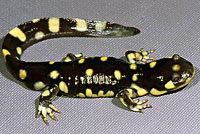 |
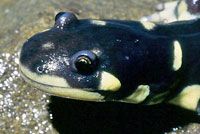 |
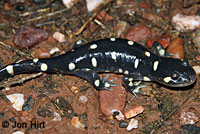 |
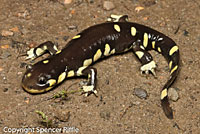 |
 |
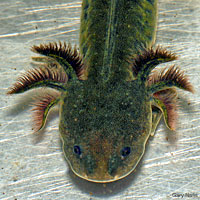 |
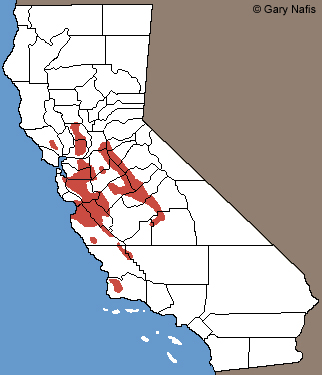 |
| Adult | Adult | Adult © Jon Hirt | Adult © Spencer Riffle | Larvae are aquatic. Gills are long - reduce in size with age. Dorsal fin is on back and tail. |
Historically found only in the red areas |
||
| Northwestern Salamander Ambystoma gracile |
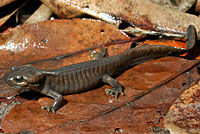 |
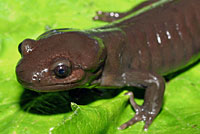 |
 |
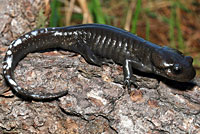 |
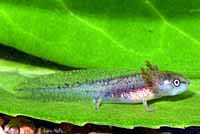 |
 |
 |
| Adult | Adult | Adult | Adult | Larvae are aquatic. Gills are long - reduce in size with age. Dorsal fin is on back and tail. |
Found only in the red area | ||
| Long-toed Salamanders - Ambystoma macrodactylum |
|||||||
| An elongated toe can help to identify Long-toed Salamanders |
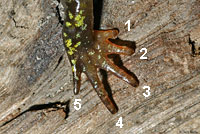 |
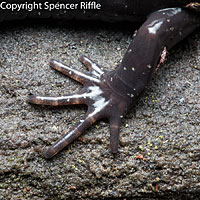 |
|||||
| The fourth toe on each back foot is longer than third toe. This is not found on other salamander species in California. | © Spencer Riffle | ||||||
| Santa Cruz Long-toed Salamander Ambystoma macrodactylum croceum |
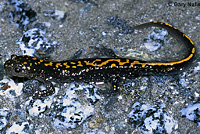 |
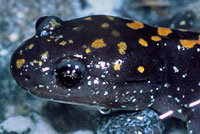 |
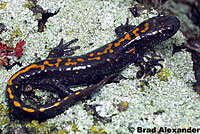 |
 |
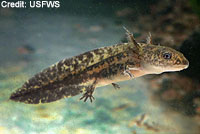 |
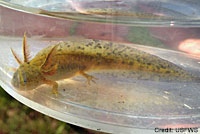 |
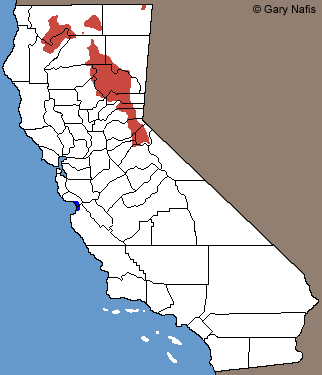 |
| Adult | Adult | Adult © Brad Alexander | Juvenile © Jon Hirt | Larvae are aquatic. Gills are long - reduce in size with age. Dorsal fin is on back and tail. |
Found in the dark blue area (Near Monterey Bay) |
||
| Southern Long-toed Salamander Ambystoma macrodactylum sigillatum |
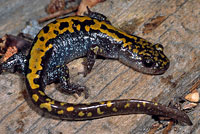 |
 |
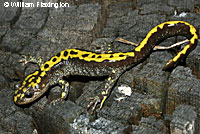 |
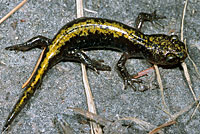 |
 |
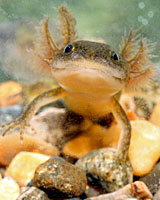 |
 |
| Adult | Adult © Chad Lane | Adult © William Flaxington | Juvenile | Larvae are aquatic. Gills are long - reduce in size with age. Dorsal fin is on back and tail. |
Found only in the red areas | ||
| Western Tiger Salamanders are Mole Salamanders that are not native to California. They have been introduced into some California lakes and ponds. Individuals found in California are probably derived from several subspecies found across the west, which accounts for the various colors and patterns which can be found. Hybrids between Western Tiger Salamanders and California Tiger Salamanders are also sometimes found in areas where California Tiger Salamanders occur. |
|||||||
| Western Tiger Salamander Ambystoma mavortium |
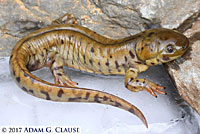 |
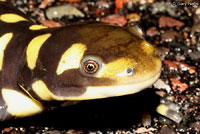 |
 |
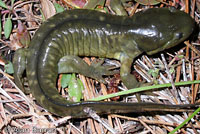 |
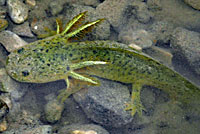 |
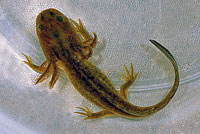 |
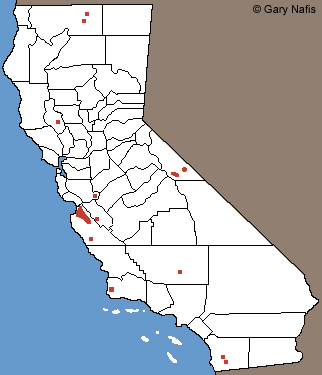 |
| Adult, Mono County © Adam Clause | Adult | Adult, Siskiyou County © Alan Barron | Adult, Siskiyou County © Alan Barron | Larvae are aquatic. Gills are long - reduce in size with age. Dorsal fin is on back and tail. |
|||
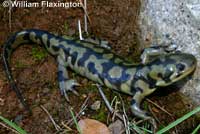 |
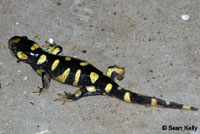 |
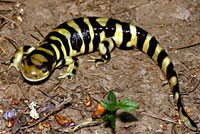 |
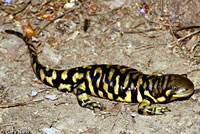 |
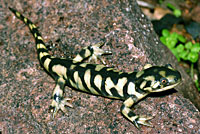 |
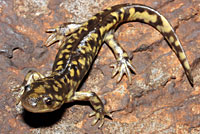 |
||
| Adult, Kern County © William Flaxington | Adult, San Diego County © Sean Kelly | Adult, Lake County | Hybrid with California Tiger Salamander | Adult, Arizona | Adult, Arizona | Found in the red areas and possibly elsewhere |
|
Giant Salamanders - genus Dicamptodon |
|||||||
| There are two species of Giant Salamanders in California. They both look alike, so use the location to help identify the species. The Coastal Giant Salamander is found north of the Mendocino County line, the California Giant Salamander is south. Giant Salamanders lay eggs in water that hatch into gilled larvae which live at the edge of streams until they lose their gills and move onto land. Aquatic neotenic adults are not uncommon. Adults are occasionally found walking near streams in daylight. |
|||||||
| California Giant Salamander Dicamptodon ensatus |
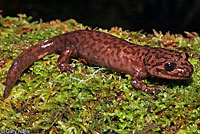 |
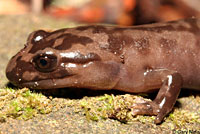 |
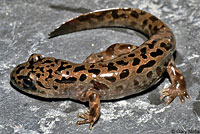 |
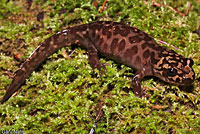 |
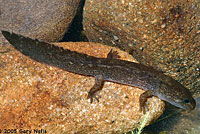 |
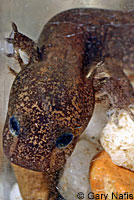 |
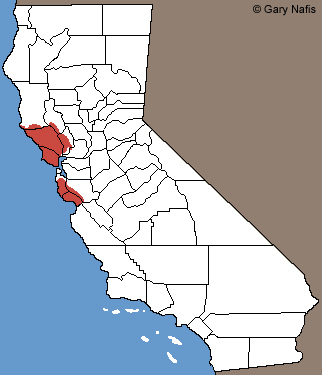 |
| Adult | Juvenile | Adult | Juvenile | Larvae are aquatic. Gills are short. Dorsal fin is on tail, not back. |
Found only in the red areas | ||
| Coastal Giant Salamander Dicamptodon tenebrosus |
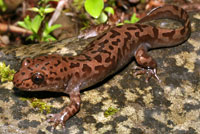 |
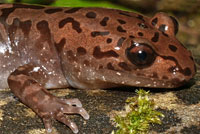 |
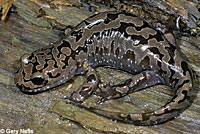 |
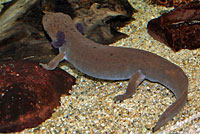 |
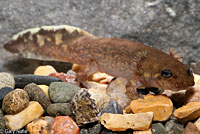 |
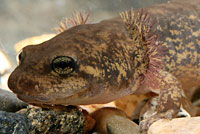 |
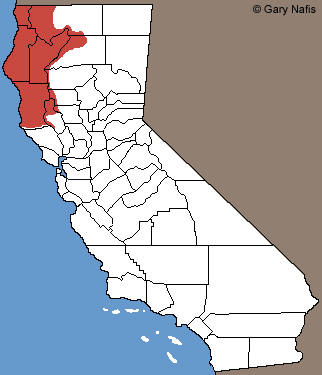 |
| Adult | Adult | Adult | Aquatic neotenic adult | Larvae are aquatic. Gills are short. Dorsal fin is on tail, not back. |
Found only in the red area | ||
Torrent Salamanders - genus Rhyacotriton |
|||||||
| Like the aquatic salamanders Torrent Salamanders have very small lungs and are often found immersed in streams, but they are also similar to terrestrial salamanders in that they spend time out of the water where they need to remain moist. Eggs are laid in streams where they hatch into gilled larvae that live in the water until they lose their gills and move onto land. |
|||||||
| Southern Torrent Salamander Rhyacotriton variegatus |
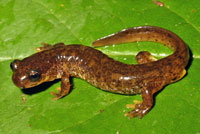 |
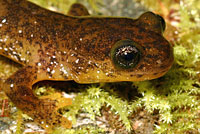 |
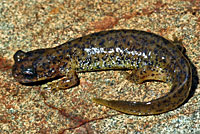 |
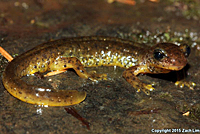 |
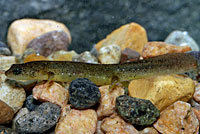 |
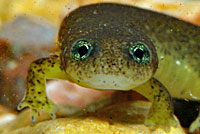 |
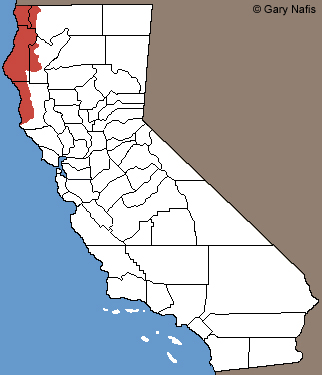 |
| Adult | Adult | Adult | Adult, © Zach Lim | Larvae are aquatic. Gills are very small. Dorsal fin is on tail, not on back |
Found only in the red area | ||
Pacific Newts - genus Taricha |
|||||||
Pacific Newts are the salamanders that are most likely to be seen walking around in daylight. They live under surface objects on land or underground but they emerge to move to water in Winter or Spring where they change into an aquatic phase that helps them swim. They are often seen walking or in ponds during their breeding migrations. They breed and lay eggs, then leave the water to live on land where they change back into their terrestrial phase. The eggs hatch into tiny gilled larva which eventually transform and leave the water to live on land. Except for the Red-bellied Newt, the only species that has all-black eyes, the other three species can be hard to identify. Click on this link to find more information to help with Pacific Newt identification, inluding larvae, in areas where more than one species occurs. |
|||||||
| Rough-skinned Newt Taricha granulosa |
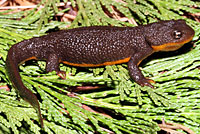 |
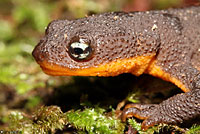 |
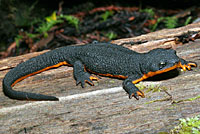 |
 |
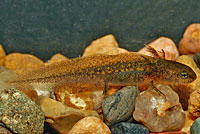 |
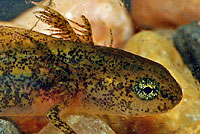 |
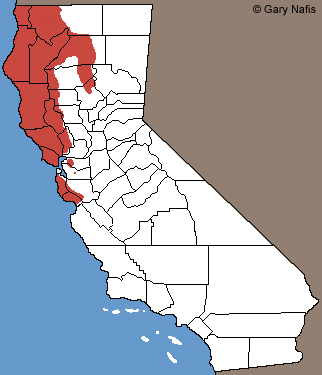 |
| Terrestrial phase adult | Terrestrial phase juvenile | Terrestrial phase adult | Aquatic phase adult | Larvae are aquatic. Stripes not present. Gills are long - reduce in size with age. Dorsal fin is on back and tail. |
Found only in the red areas | ||
| Red-bellied Newt Taricha rivularis |
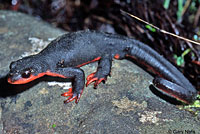 |
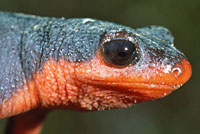 |
 |
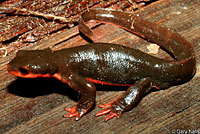 |
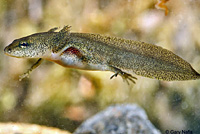 |
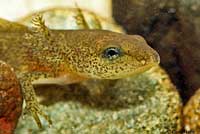 |
 |
| Terrestrial phase adult | Unlike the other Pacific Newts which have a yellow patch in their eyes, the eyes of Red-bellied Newts are all black. | Aquatic phase adult | Aquatic phase adult | Larvae are aquatic. Stripes not present. Gills are long - reduce in size with age. Dorsal fin is on back and tail. |
Found only in the red area | ||
| Sierra Newt Taricha sierrae |
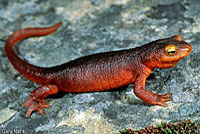 |
 |
 |
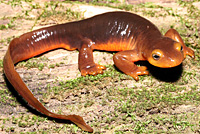 |
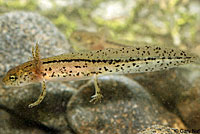 |
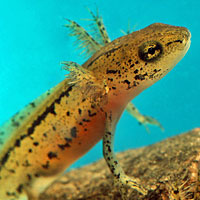 |
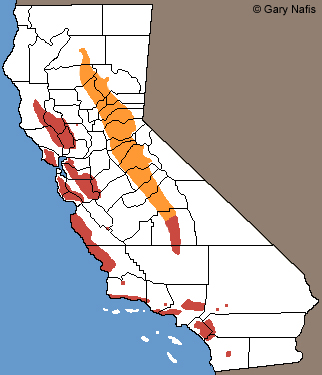 |
| Terrestrial phase adult | Adult | Terrestrial phase adult | Aquatic phase adult | Larvae are aquatic. Stripes are present. Gills are long - reduce in size with age. Dorsal fin is on back and tail. |
Found only in the orange area | ||
| Coast Range Newt Taricha torosa |
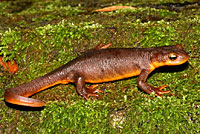 |
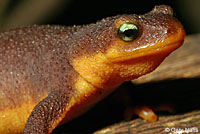 |
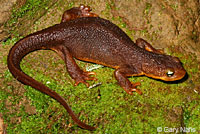 |
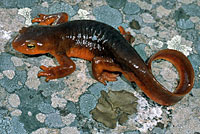 |
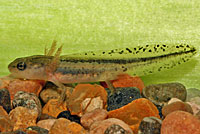 |
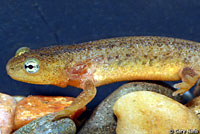 |
 |
| Terrestrial phase adult | Terrestrial phase adult | Terrestrial phase adult | Aquatic phase adult | Larvae are aquatic. (left) young (right) mature Stripes are present. Gills are long - reduce in size with age. Dorsal fin is on back and tail. |
Found only in the red areas | ||
Terrestrial Salamanders - Family Plethodontidae (Found on land, not in water) |
|||||||
| The following terrestrial salamanders all live in moist places on land, emerging at night to hunt. They are rarely found active in the daytime. They are typically found under rocks, logs, and other surface objects and they are occasionally seen walking at night. They need to stay moist but they are rarely found in water since they respire through their skin instead of using lungs. They breed and lay their eggs in moist places on land, not in water like the aquatic salamanders. The young hatch fully-formed as a miniature version of the terrestrial adults, but they are sometimes colored differently than adults. Males and females of all of these species are similar enough in appearance that knowing the sex of a salamander will not help to identify a species. |
|||||||
Climbing Salamanders - genus Aneides |
|||||||
| Climbing Salamanders have thick toe tips that are specially adapted to help them climb steep surfaces such as rocks and trees. |
|||||||
Black Salamanders - Aneides flavipunctatus complex - Found in several colors and patterns. There are four separate species but they do not correspond exactly to the different colors and patterns. Hatchling juveniles often look very different from the adults with yellow or greenish coloring. |
|||||||
| Speckled Black Salamander Aneides flavipunctatus (Spotted Form) |
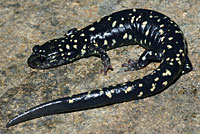 |
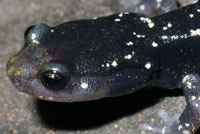 |
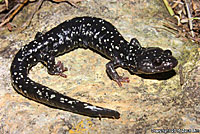 |
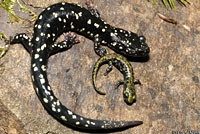 |
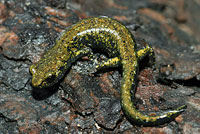 |
 |
 |
| Adult | Sub-adult | Adult © Zach Lim | Adult and juvenile | Juvenile | Black Salamanders have rounded toe tips |
The Speckled Black Salamander is found in the Purple area |
|
| (Black Form) | 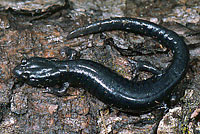 |
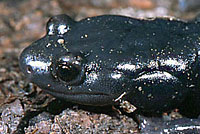 |
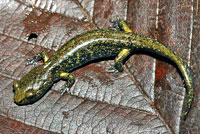 |
||||
| Adult | Adult | Juvenile | |||||
| (Frosted Form) | 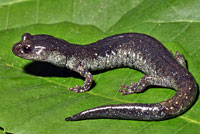 |
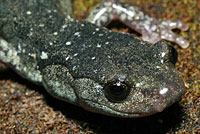 |
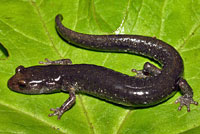 |
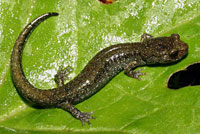 |
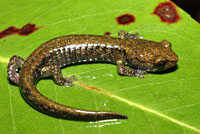 |
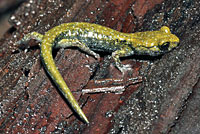 |
|
| Adult | Adult | Adult | Sub-adult | Juvenile | Juvenile | ||
| Shasta Black Salamander Aneides iecanus |
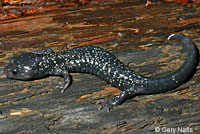 |
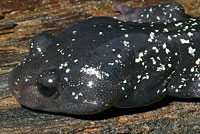 |
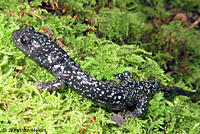 |
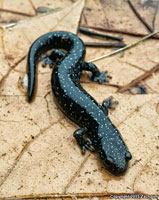 |
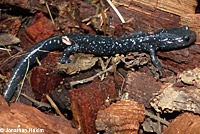 |
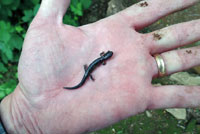 |
 |
| Adult | Adult | Adult © Jonathan Hakim | Adult © Zach Lim | Adult © Jonathan Hakim | Juvenile © Mark Gary | Found in the Orange areas | |
| Klamath Black Salamander Aneides klamathensis |
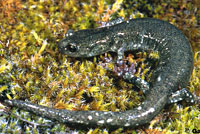 |
 |
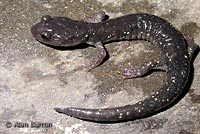 |
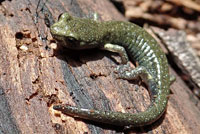 |
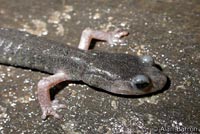 |
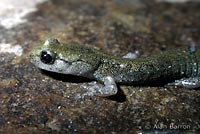 |
 |
| Adult | Adult | Adult © Alan Barron | Adult | Sub-adult © Alan Barron | Juvenile © Alan Barron | Found in the Red area | |
| Santa Cruz Black Salamander Aneides niger |
 |
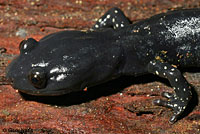 |
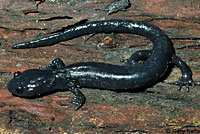 |
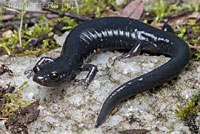 |
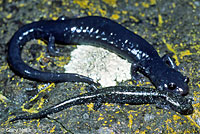 |
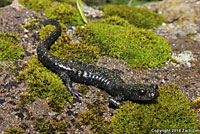 |
 |
| Adult | Adult | Adult | Adult © Spencer Riffle | Adult and juvenile | Juvenile © Zachary Lim | Found in the Dark Blue area | |
Arboreal Salamanders can have varying amounts of spotting on the body - from very fine spots to very large ones - and varying background colors, but they are all the same species. Hatchling and very young juvenile Arboreal Salamanders do not look like the adults, having a very dark background with a wash of light markings, not just spots. |
|||||||
| Arboreal Salamander Aneides lugubris |
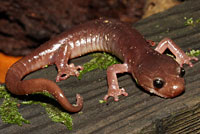 |
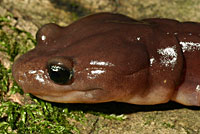 |
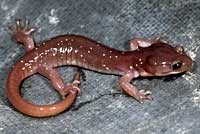 |
 |
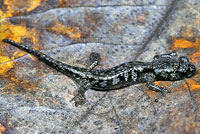 |
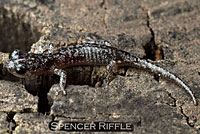 |
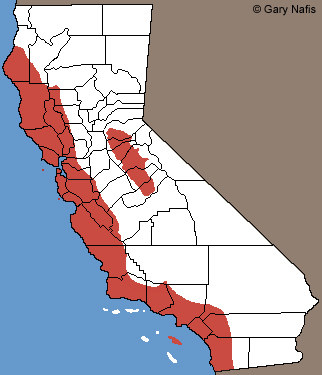 |
| Adult | Adult | Adult | Adult | Juvenile | Hatchling © Spencer Riffle | Found only in the red areas | |
Clouded Salamanders are very similar to Wandering Salamanders in appearance and behavior, so use the range maps to help identify them where both species occur in California. Both species are typically found under the bark of fallen trees. |
|||||||
| Clouded Salamander Aneides ferreus |
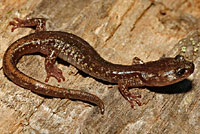 |
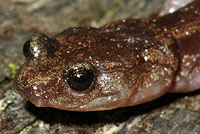 |
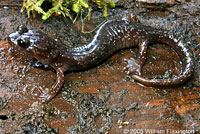 |
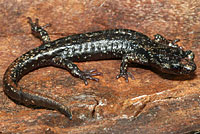 |
 |
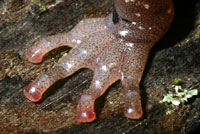 |
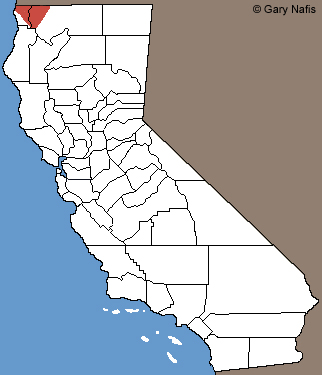 |
| Adult | Adult | Adult © William Flaxington | Sub-adult | Juvenile | Clouded Salamanders have squared-off toe tips |
Found only in the red area | |
| Wandering Salamander Aneides vagrans |
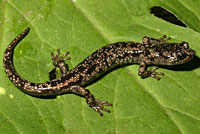 |
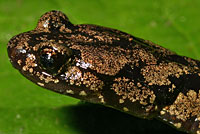 |
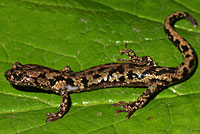 |
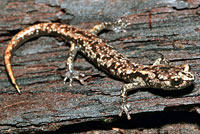 |
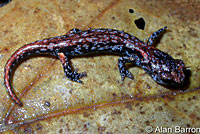 |
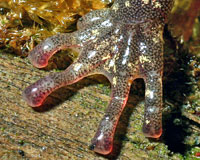 |
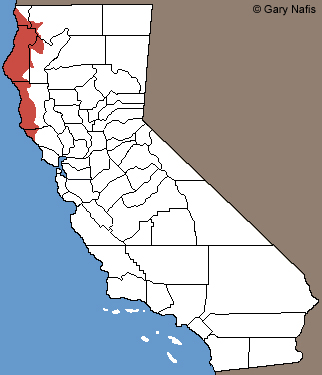 |
| Adult | Adult | Adult | Sub-adult | Juvenile © Alan Barron | Wandering Salamanders have squared-off toe tips. |
Found only in the red area | |
Slender Salamanders - genus Batrachoseps
|
|||||||
| Slender Salamanders are small worm-like salamanders with tiny legs that are sometimes not noticed. The different species are hard to identify by appearance, so use the range maps to help identify them since in most areas only one species is found. |
|||||||
| Range map of all Slender Salamanders in California: |
|||||||
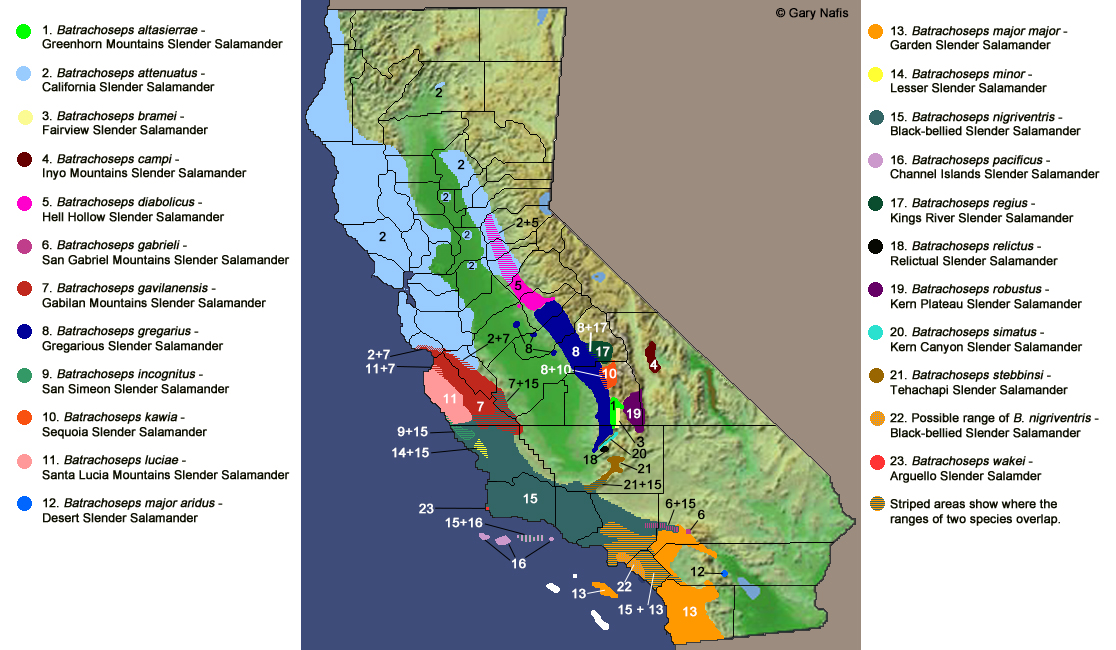 |
|||||||
| Physical characteristics that can help to identify Slender Salamanders |
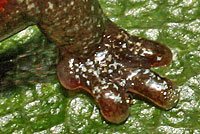 |
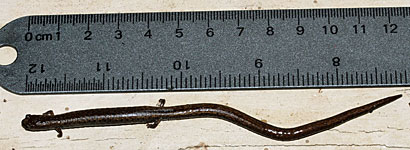 |
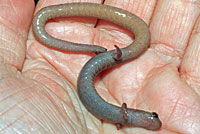 |
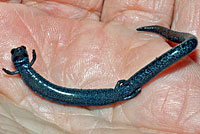 |
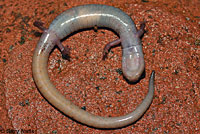 |
||
| Slender Salamanders have only 4 toes on their hind feet. All other California salamanders have 5 toes on their hind feet. |
Slender salamanders have long thin bodies. The tail can be longer that the body but the tail can also be broken off. The legs are very small and they are sometimes not seen. Slender Salamanders are sometimes mistaken for a worm or a tiny snake when the legs are not seen. | In some areas of southern California two species of Slender Salamanders can be found. They can usually be identified by looking at the underside. Left: The Southern California Slender Salamander has a light underside. Right: The Black-bellied Slender Salamander has a dark underside. |
The Island Slender Salamander also has a light underside. It is found on Santa Cruz Island along with the Black-bellied Slender Salamander (left). | ||||
| Greenhorn Mountains Slender Salamander Batrachoseps altasierrae |
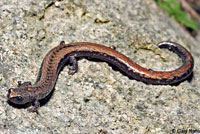 |
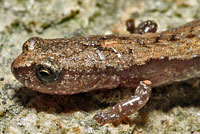 |
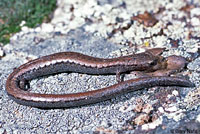 |
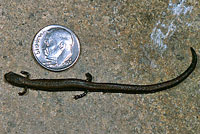 |
 |
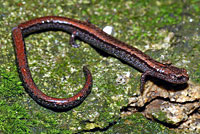 |
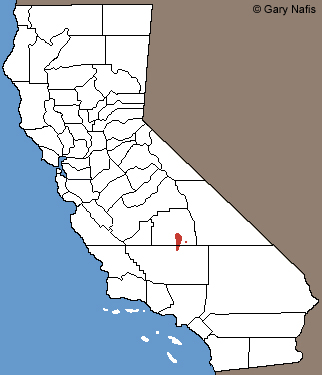 |
| Adult | Adult | Adult | Adult | Adult © Ryan Sikola | Adult | Found only in the red area | |
| Desert Slender Salamander Batrachoseps aridus |
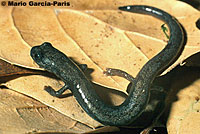 |
 |
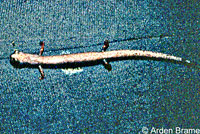 |
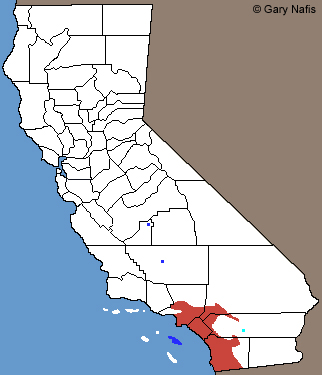 |
|||
| Adult © Mario Garcia-Paris | Adult © Mario Garcia-Paris | Adult © Arden Brame (courtesy of Harold De Lisle.) |
Found in the bright blue area (Isolated desert canyons in Riverside County only.) |
||||
| California Slender Salamander Batrachoseps attenuatus |
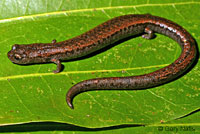 |
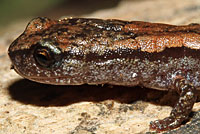 |
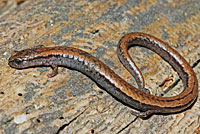 |
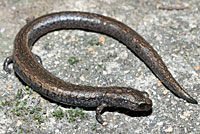 |
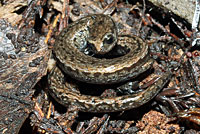 |
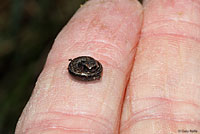 |
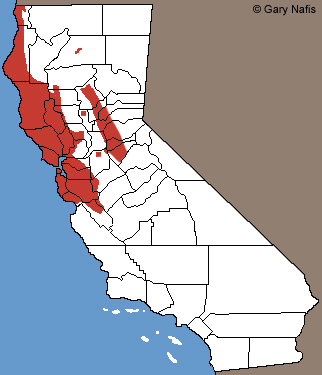 |
| Adult | Adult | Adult | Adult | Adult | Tiny Juvenile | Found only in the red areas | |
| Fairview Slender Salamander Batrachoseps bramei |
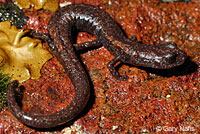 |
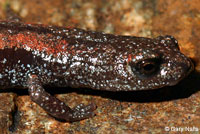 |
 |
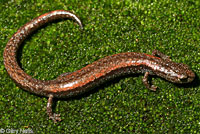 |
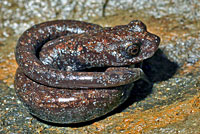 |
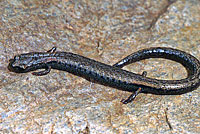 |
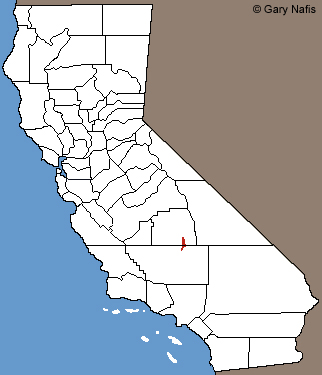 |
| Adult | Adult | Adult | Adult | Adult | Adult | Found only in the red area | |
| Inyo Mountains Slender Salamander Batrachoseps campi |
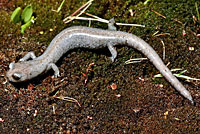 |
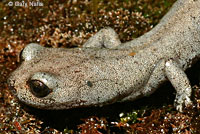 |
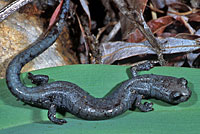 |
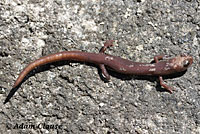 |
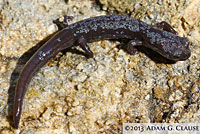 |
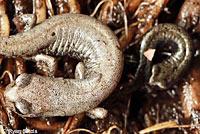 |
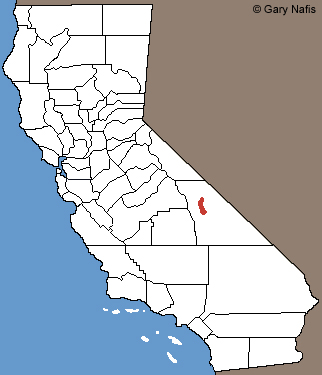 |
| Adult | Adult | Adult | Adult © Adam Clause | Adult © Adam Clause | Adult and juvenile, © Ryan Sikola | Found only in the red areas | |
| Hell Hollow Slender Salamander Batrachoseps diabolicus |
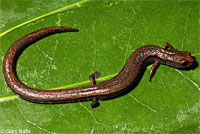 |
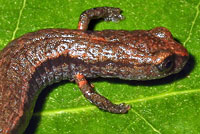 |
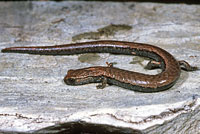 |
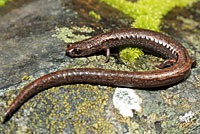 |
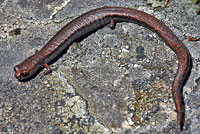 |
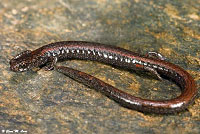 |
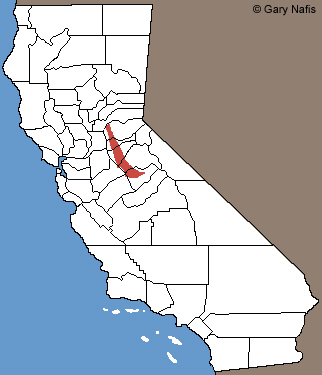 |
| Adult | Adult | Adult | Adult | Adult | Adult © Chad M. Lane | Found only in the red area | |
| San Gabriel Mountains Slender Salamander Batrachoseps gabrieli |
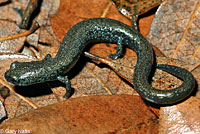 |
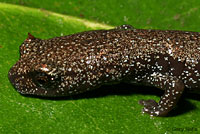 |
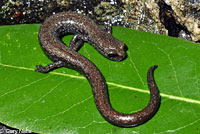 |
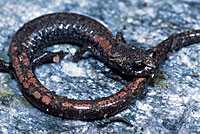 |
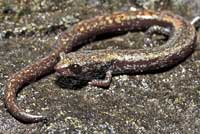 |
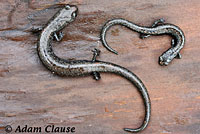 |
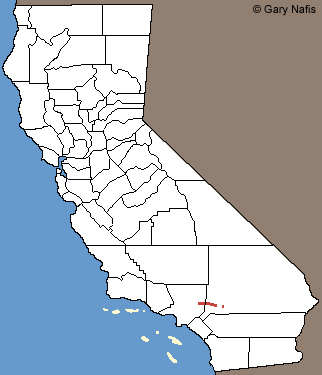 |
| Adult | Adult | Adult | Adult | Adult | Adult and Juvenile © Adam Clause | Found only in the red areas | |
| Gabilan Mountains Slender Salamander Batrachoseps gavilanensis |
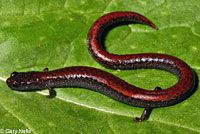 |
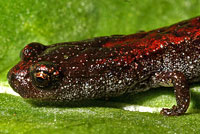 |
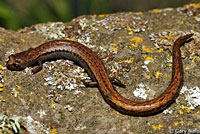 |
 |
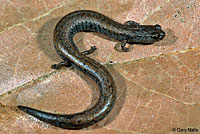 |
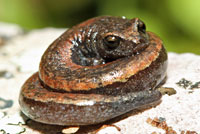 |
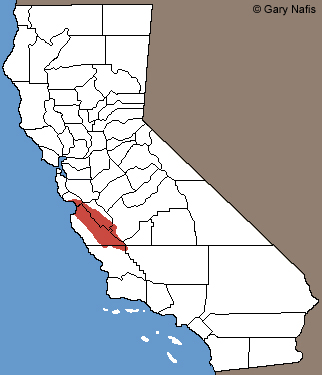 |
| Adult | Adult | Adult | Adult | Adult | Juvenile | Found only in the red area | |
| Gregarious Slender Salamander Batrachoseps gregarius |
 |
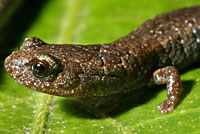 |
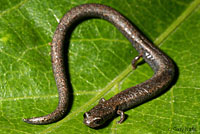 |
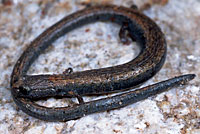 |
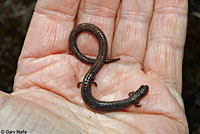 |
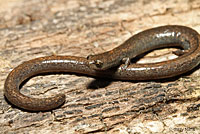 |
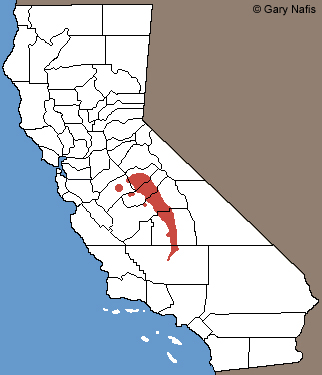 |
| Adult | Adult | Adult | Adult | Adult | Adult | Found only in the red area | |
| San Simeon Slender Salamander Batrachoseps incognitus |
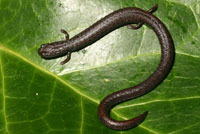 |
 |
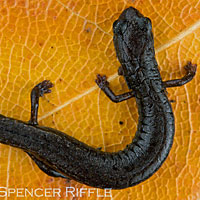 |
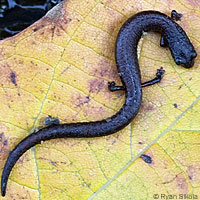 |
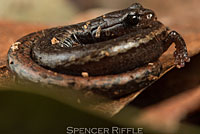 |
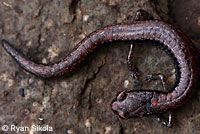 |
 |
| Adult | Adult | Adult © Spencer Riffle | Adult © Ryan Sikola | Adult © Spencer Riffle | Juvenile © Ryan Sikola | Found only in the red area | |
| Sequoia Slender Salamander Batrachoseps kawia |
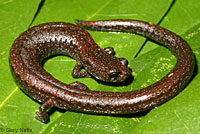 |
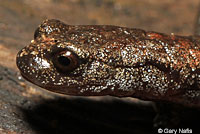 |
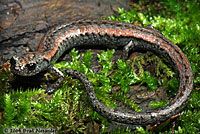 |
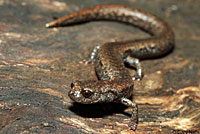 |
 |
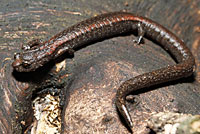 |
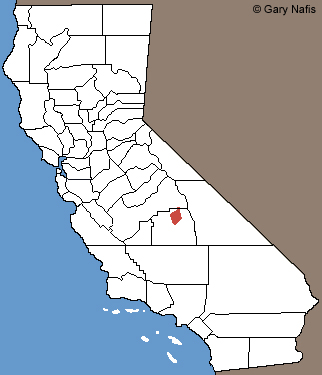 |
| Adult | Adult |
Adult © Brad Alexander | Adult | Adult | Adult | Found only in the red area | |
| Santa Lucia Mountains Slender Salamander Batrachoseps luciae |
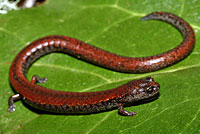 |
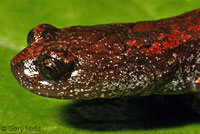 |
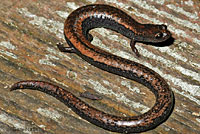 |
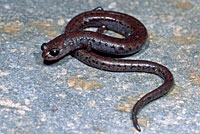 |
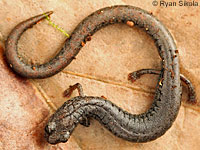 |
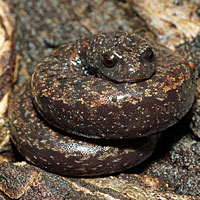 |
 |
| Adult | Adult | Adult | Adult | Adult © Ryan Sikola | Juvenile | Found only in the red area | |
| Southern California Slender Salamander Batrachoseps major |
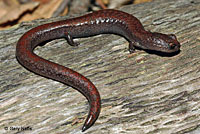 |
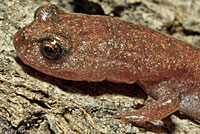 |
 |
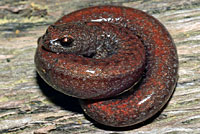 |
 |
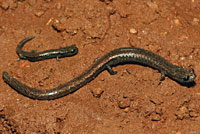 |
 |
| Adult | Adult | Adult | Adult | The underside is light in color. | Adult and juvenile | Found in the red and blue areas | |
| Lesser Slender Salamander Batrachoseps minor |
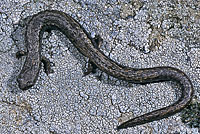 |
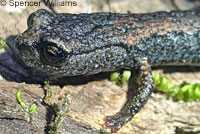 |
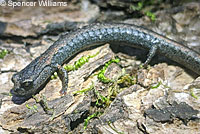 |
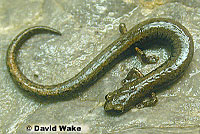 |
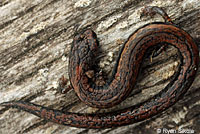 |
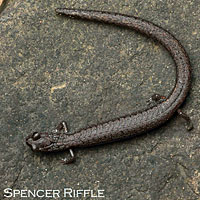 |
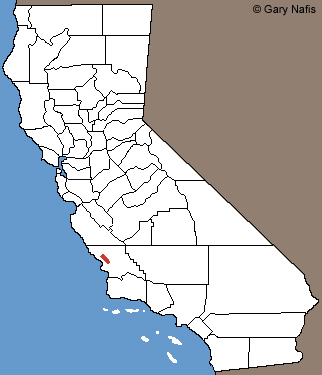 |
| Adult | Adult © Spencer Williams | Adult © Spencer Williams | Adult © David Wake | Adult © Ryan Sikola | Adult © Spencer Riffle | Found only in the red area | |
| Black-bellied Slender Salamander Batrachoseps nigriventris |
 |
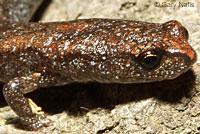 |
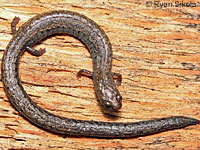 |
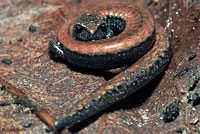 |
 |
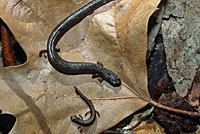 |
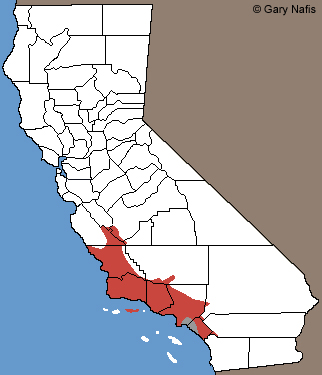 |
| Adult | Adult | Adult © Ryan Sikola | Adult | The underside is dark in color. | Adult and Juvenile | Found only in the red area | |
| Channel Islands Slender Salamander Batrachoseps pacificus |
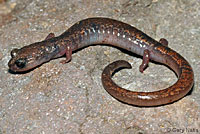 |
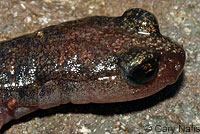 |
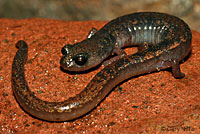 |
 |
 |
 |
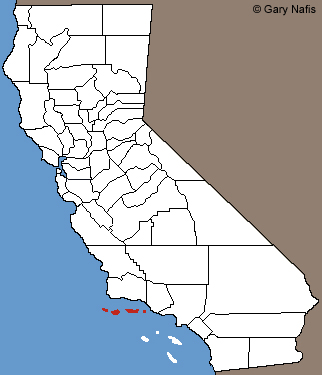 |
| Adult | Adult | Adult | Adult © Spencer Williams | Adult | The underside is light in color | Found only in the red areas (Channel Islands only) |
|
| Kings River Slender Salamander Batrachoseps regius |
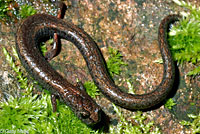 |
 |
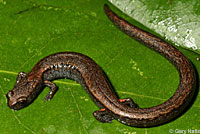 |
 |
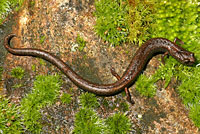 |
 |
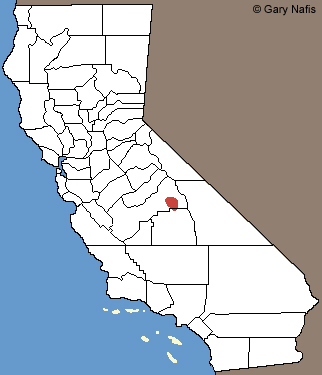 |
| Adult | Adult | Adult | Adult | Adult | Adult | Found only in the red area | |
| Relictual Slender Salamander Batrachoseps relictus |
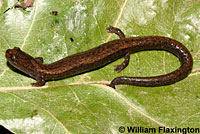 |
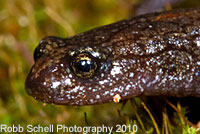 |
 |
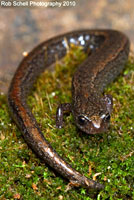 |
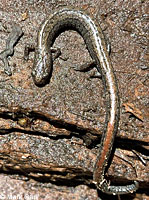 |
 |
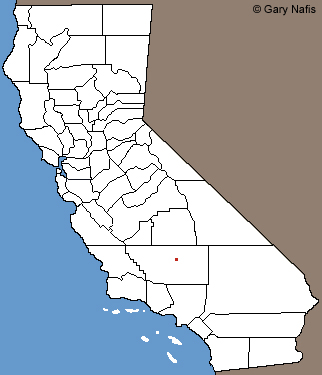 |
| Adult © William Flaxington | Adult © Robb Schell | Adult © Brad Alexander | Adult © Rob Schell | Adult © Mark Gary | Adult and juveniles © Noah Morales | Found only in the red area | |
| Kern Plateau Slender Salamander Batrachoseps robustus |
 |
 |
 |
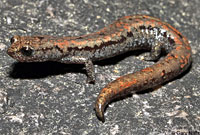 |
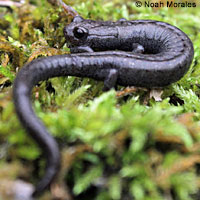 |
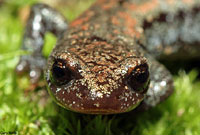 |
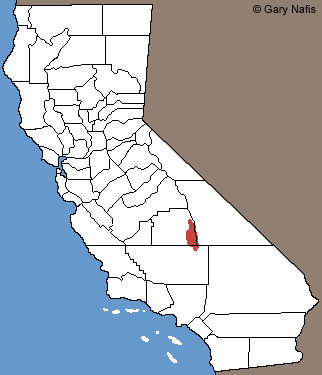 |
| Adult | Adult | Adult | Adult | Adult © Noah Morales | Adult | Found only in the red area | |
| Kern Canyon Slender Salamander Batrachoseps simatus |
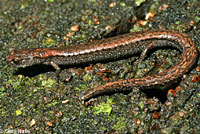 |
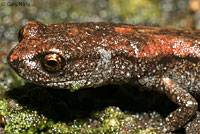 |
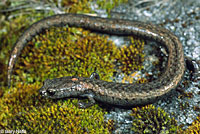 |
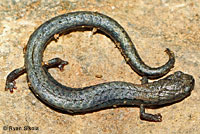 |
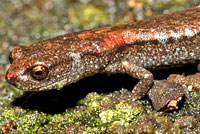 |
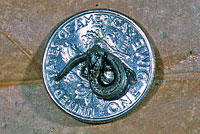 |
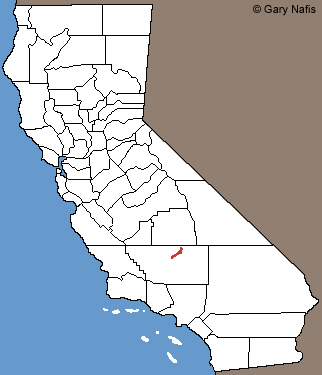 |
| Adult | Adult | Adult | Adult © Ryan Sikola | Adult | Hatchling on U.S. ten-cent coin | Found only in the red area | |
| Tehachapi Slender Salamander Batrachoseps stebbinsi |
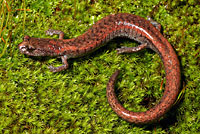 |
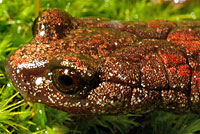 |
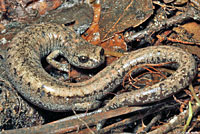 |
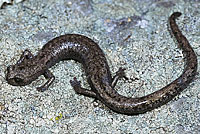 |
 |
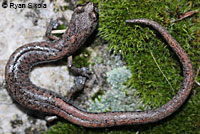 |
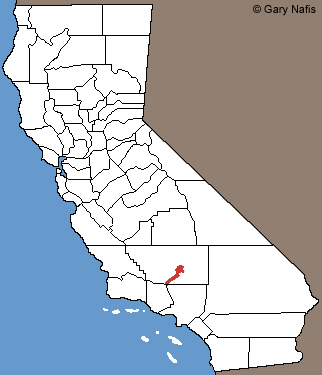 |
| Adult | Adult | Adult | Adult | Adult | Adult © Ryan Sikola |
Found only in the red area | |
| Arguello Slender Salamander Batrachoseps wakei |
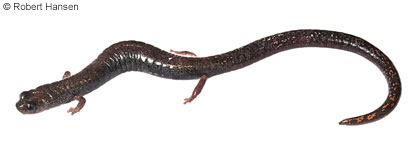 |
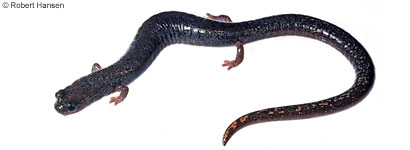 |
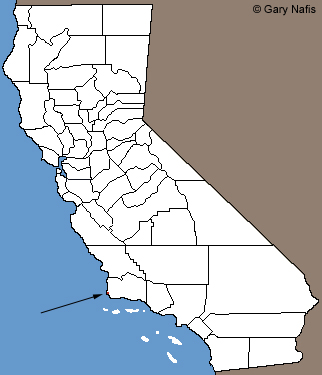 |
||||
| Adult © Robert Hansen | Adult © Robert Hansen | Found only in the tiny red area | |||||
Ensatina - Ensatina eschscholtzii |
|||||||
The genus Ensatina currently consists of one species - eschscholtzii - with seven different subspecies which can be identified by color and pattern and by range. (Ensatina klauberi is also recognized as a full species by some herpetologists.) |
|||||||
| Physical characteristics that can help to identify Ensatina | 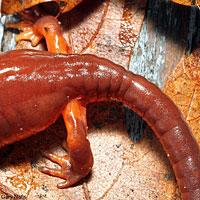 |
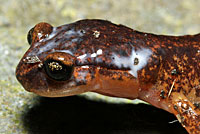 |
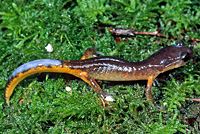 |
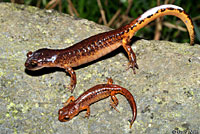 |
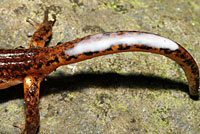 |
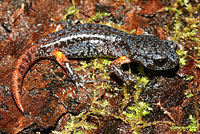 |
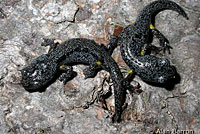 |
| Unlike other salamanders, the tail of an Ensatina is constricted at its base | When threatened, Ensatina often assume a defensive stance with the legs and tails raised as they excrete a milky substance from their tail and neck. | Juveniles of some subspecies are similar to adults, but other subspecies juveniles can be very dark, unlike adults, with orange or yellow on the legs and sometimes the tail | Juveniles © Alan Barron | ||||
| Yellow-blotched Ensatina Ensatina eschscholtzii croceater |
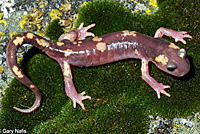 |
 |
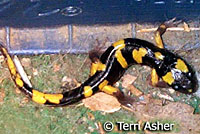 |
 |
 |
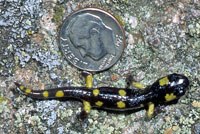 |
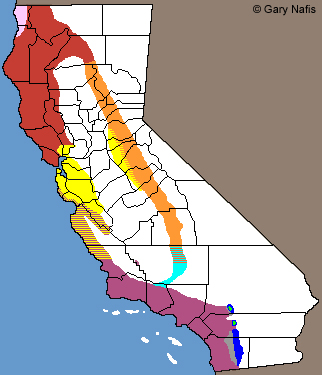 |
| Adult | Adult | Adult | Adult | Adult | Juvenile | Found in the dark blue areas | |
| Monterey Ensatina Ensatina eschscholtzii eschscholtzii |
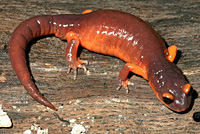 |
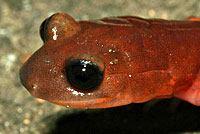 |
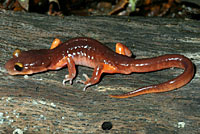 |
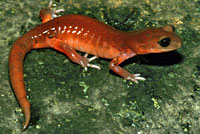 |
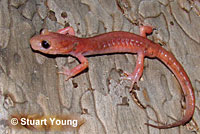 |
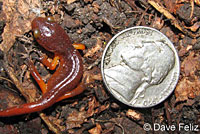 |
 |
| Adult | Adult | Adult | Adult | Adult | Juvenile | Found in the purple areas | |
| Large-blotched Ensatina Ensatina eschscholtzii klauberi |
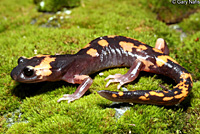 |
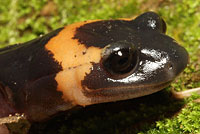 |
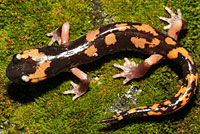 |
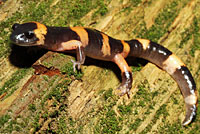 |
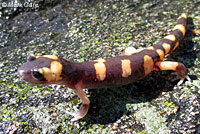 |
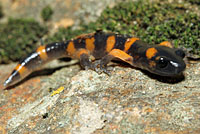 |
 |
| Adult | Adult | Adult | Adult | Adult | Juvenile | Found in the bright blue area | |
| Oregon Ensatina Ensatina eschscholtzii oregonensis |
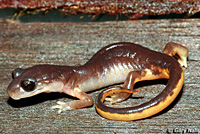 |
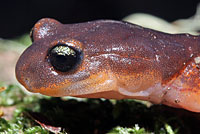 |
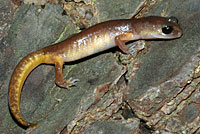 |
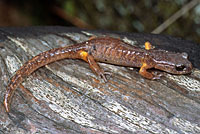 |
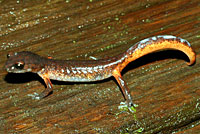 |
 |
 |
| Adult | Adult | Adult | Adult | Adult | Juvenile | Found in the red area | |
| Painted Ensatina Ensatina eschscholtzii picta |
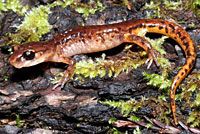 |
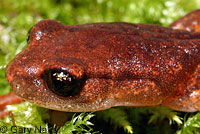 |
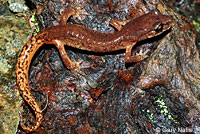 |
 |
 |
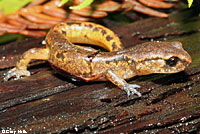 |
 |
| Adult | Adult | Adult | Adult | Juveniles © Alan Barron | Juvenile | Found in the pink area | |
| Sierra Nevada Ensatina Ensatina eschscholtzii platensis |
 |
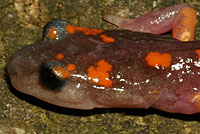 |
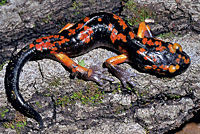 |
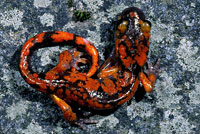 |
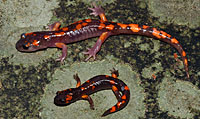 |
 |
 |
| Adult | Adult | Adult | Adult | Adult and juvenile | Juvenile | Found in the orange area | |
| Yellow-eyed Ensatina Ensatina eschscholtzii xanthoptica |
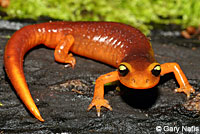 |
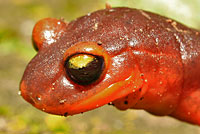 |
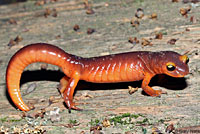 |
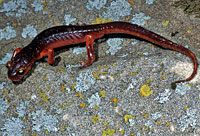 |
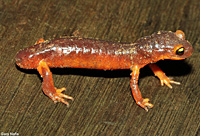 |
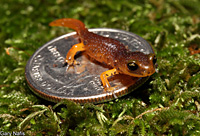 |
 |
| Adult | Adult | Adult | Adult | Adult without tail | Juvenile | Found in the yellow areas | |
Web-footed Salamanders - genus Hydromantes |
|||||||
| Web-footed Salamanders are associated with moist rocky areas, including granite and limestone cliffs, caves, and caverns. The rear feet have slightly-webbed toes which aid in climbing steep rock surfaces. They can be easily identified by their location, but in the area around Lake Shasta there are three similar species, so be sure to check the enlarged range map. |
|||||||
| Physical characteristics that can help to identify Web-footed Salamanders |
 |
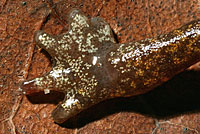 |
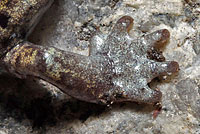 |
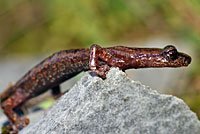 |
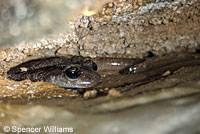 |
||
| The rear feet have webbed toes | Webbed toes | Webbed toes | The body can be flattened to fit into narrow rock crevices |
Adult in rock crack © Spencer Williams | |||
| Limestone Salamander Hydromantes brunus |
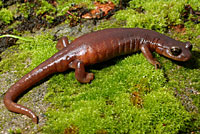 |
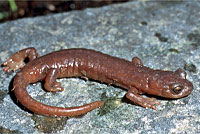 |
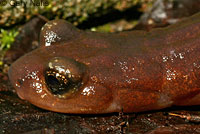 |
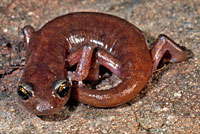 |
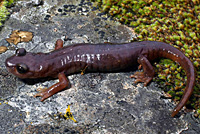 |
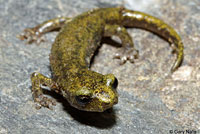 |
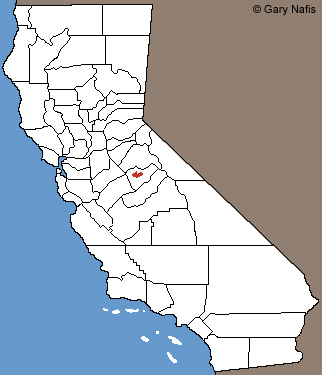 |
| Adult | Adult | Adult | Adult | Adult | Juveniles are greenish yellow | Found only in the red area | |
| Mount Lyell Salamander Hydromantes platycephalus |
 |
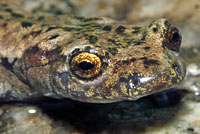 |
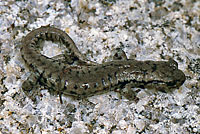 |
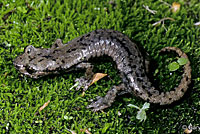 |
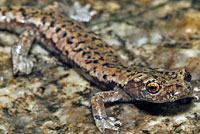 |
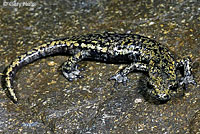 |
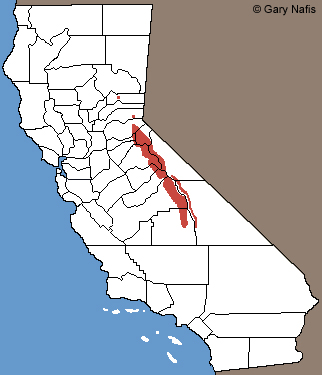 |
| Adult | Adult | Adult | Adult | Adult | Juvenile | Found only in the red area | |
| Samwel Shasta Salamander Hydromantes samweli |
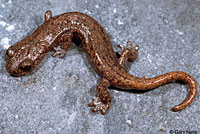 |
 |
 |
 |
 |
 |
 |
| Adult | Adult | Adult | Adult | Adult and juvenile | Juvenile | Found only in the yellow area See enlarged range map |
|
| Shasta Salamander Hydromantes shastae |
 |
 |
 |
 |
 |
 |
|
| Adult © Noah Morales | Adult © Noah Morales | Adult © Spencer Riffle | Adult © Spencer Riffle | Adult © Noah Morales | Found only in the orange area See enlarged range map |
||
| Wintu Shasta Salamader Hydromantes wintu |
 |
 |
 |
 |
 |
 |
 |
| Adult © Spencer Williams | Adult © Noah Morales | Adult © Noah Morales | Adult © Noah Morales | Adult © Spencer Williams | Juvenile © Noah Morales | Found only in the red area See enlarged range map |
|
Woodland Salamanders - genus Plethodon |
|||||||
Woodland Salamanders found in California are similar in size and appearance, but their ranges are limited where they are only found in woodlands in the extreme northwest part of the state. Use the range maps to help identify them. |
|||||||
| Range maps of all Woodland salamanders in California |
|||||||
 |
 |
||||||
| Pink - Plethodon asupak - Scott Bar Salamander Light Blue - Plethodon dunni - Dunn's Salamander Dark Blue - Plethodon elongatus - Del Norte Salamander (P. dunni and P. elongatus ranges overlap in the checkered area) Red - Plethodon stormi - Siskiyou Mountains Salamander |
|||||||
| Scott Bar Salamander Plethodon asupak |
 |
 |
 |
 |
 |
 |
 |
| Adult | Adult | Adult | Adult © Alan Barron | Adult, and juvenile © Tim Burkhardt |
Juveniles have reddish stripes on the back |
Found only in the red area | |
| Dunn's Salamander Plethodon dunni |
 |
 |
 |
 |
 |
 |
 |
| Adult | Adult | Adult | Adult | Adult | Juvenile © Alan Barron | Found only in the red area | |
| Del Norte Salamander Plethodon elongatus |
 |
 |
 |
 |
 |
 |
 |
| Adult | Adult | Adult | Adult | Adult and juvenile | Juveniles | Found only in the red area | |
| Siskiyou Mountains Salamander Plethodon stormi |
 |
 |
 |
 |
 |
 |
 |
| Adult | Adult | Adult | Adult | Adult © Spencer Riffle | Juvenile | Found only in the red area | |
 |
|||||||
Return to the top
© 2000 -